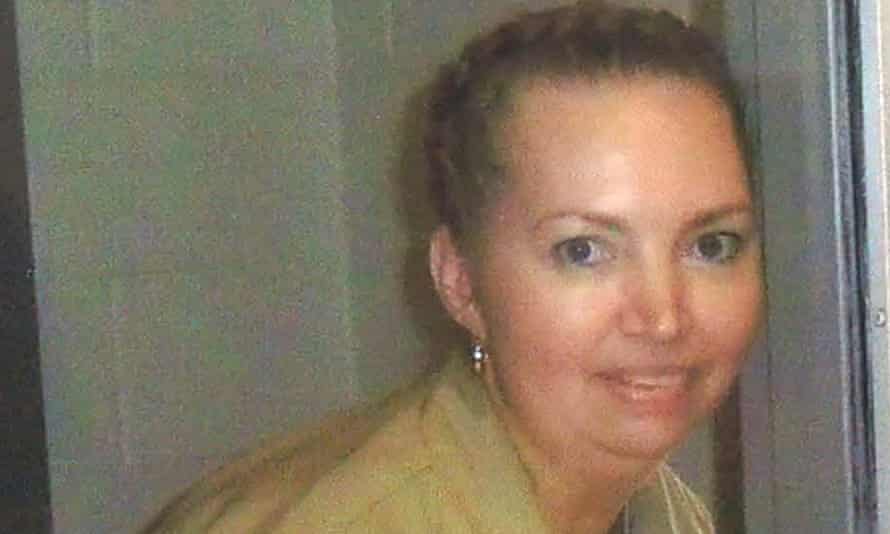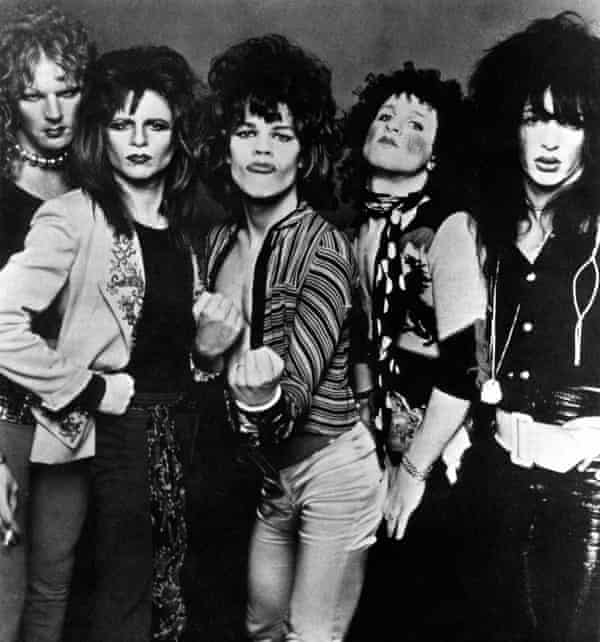UPDATED
Trump administration condemned over Lisa Montgomery executionAdministration accused of ‘unnecessary and vicious use of authoritarian power’

Lisa Montgomery was executed by lethal injection in Indiana. Photograph: Reuters
Luke Harding and agencies
Wed 13 Jan 2021
A lawyer has accused the Trump administration of “unnecessary and vicious use of authoritarian power” after a woman on death row was executed early on Wednesday, the first federal execution of a woman in almost seven decades.
Lisa Montgomery, 52, was pronounced dead at 1.31am on Wednesday after receiving a lethal injection. She died at the federal prison complex in Terre Haute, Indiana, after the US supreme court lifted a stay of execution and rejected a request from her legal team for delay.
Luke Harding and agencies
Wed 13 Jan 2021
A lawyer has accused the Trump administration of “unnecessary and vicious use of authoritarian power” after a woman on death row was executed early on Wednesday, the first federal execution of a woman in almost seven decades.
Lisa Montgomery, 52, was pronounced dead at 1.31am on Wednesday after receiving a lethal injection. She died at the federal prison complex in Terre Haute, Indiana, after the US supreme court lifted a stay of execution and rejected a request from her legal team for delay.
HER DEATH MASK SHOULD HANG ABOVE THEIR HEADS
Montgomery was the 11th prisoner to be killed by lethal injection since Donald Trump resumed federal executions last July after a 17-year hiatus. The president is an ardent supporter of capital punishment.
Kelly Henry, Montgomery’s longtime attorney, denounced the move. “The craven bloodlust of a failed administration was on full display tonight,” Henry said in a statement posted on Twitter. “Everyone who participated in the execution of Lisa Montgomery should feel shame.”
She added: “The government stopped at nothing in its zeal to kill this damaged and delusional woman. Lisa Montgomery’s execution was far from justice. We should recognise [it] for what it was: the vicious, illegal and unnecessary use of authoritarian power. We cannot let this happen again.”
It came after hours of legal wrangling before the supreme court cleared the way for the execution to go ahead. Montgomery was the first of the final three federal inmates scheduled to die before next week’s inauguration of Joe Biden as president, who is expected to discontinue federal executions.
‘A lifetime of torture’: the story of the woman Trump is rushing to execute
Read more
On Tuesday a federal judge for the District of Columbia halted the scheduled executions later this week of Corey Johnson and Dustin Higgs. Johnson, convicted of killing seven people related to his drug trafficking in Virginia, and Higgs, convicted of ordering the murders of three women in Maryland, both tested positive for Covid-19 last month.
In 2004 Montgomery killed 23-year-old Bobbie Jo Stinnett in the north-west Missouri town of Skidmore. She used a rope to strangle Stinnett, who was eight months pregnant, and then cut the baby girl from the womb with a kitchen knife. Montgomery took the child with her and attempted to pass the girl off as her own.
The girl survived. Brought up by her father, she turned 16 last month on the anniversary of her mother’s death. The New York Times quoted some of those close to her as saying that Montgomery’s death was a just conclusion to the case. The crime haunted the Missouri community for years, it added.
Montgomery was originally due to be executed last month. A judge delayed it after two of her lawyers contracted coronavirus. Her attorneys argued that she suffered from mental illness, neurological impairment and complex trauma. On Monday a federal judge in Indiana stayed her execution so the court could establish her competency.
On Tuesday, however, an appeals court panel overruled this stay, saying it could have been brought earlier. Two further courts – in the district of Columbia and the eighth circuit court – issued their own separate stays. But the US supreme court ruled on Tuesday that the execution could proceed, as it has done in all previous Trump-era executions.
Montgomery was taken from a Texas prison to the Terre Haute facility, fully shackled. She was kept in a cell in the complex. In the moments before her death a female prison guard removed Montgomery’s face mask and asked her if she had any last words. She reportedly replied “no”. “I don’t believe she has any rational comprehension of what’s going on at all,” Henry said.
Montgomery’s legal team says she was subjected to “sexual torture”, including gang rapes, as a child, permanently scarring her emotionally and exacerbating mental health issues that ran in her family.
At trial, prosecutors accused Montgomery of faking mental illness, noting that her killing of Stinnett was premeditated and included meticulous planning, including online research on how to perform a C-section.
Henry said extensive testing and brain scans supported the diagnosis of mental illness. “You can’t fake brain scans that show the brain damage,” she said.
Henry said the issue at the core of the legal arguments was not whether she knew the killing was wrong in 2004 but whether she fully grasped why she was slated to be executed now.
In his ruling on a stay, the US district judge James Patrick Hanlon in Terre Haute cited defence experts who said Montgomery suffered from depression, borderline personality disorder and post-traumatic stress disorder.
He said Montgomery also suffered around the time of the killing from an extremely rare condition called pseudocyesis, in which a woman’s false belief she is pregnant triggers hormonal and physical changes as if she were actually pregnant.
Montgomery also experienced delusions and hallucinations, believing God spoke with her through connect-the-dot puzzles, the judge said, citing expert witnesses.
“The record before the court contains ample evidence that Ms Montgomery’s current mental state is so divorced from reality that she cannot rationally understand the government’s rationale for her execution,” the judge said.

Lisa Montgomery Is The First Woman Executed By The Federal Government In Almost 70 Years
Update (January 13, 9:30 a.m.): Lisa Montgomery, 52, was executed early Wednesday morning by lethal injection at the Federal Correctional Complex in Terre Haute, Indiana. She is the first woman to be executed by the federal government since 1953. Her execution commenced after the Supreme Court denied a competency hearing that suggested Montgomery should have never been eligible for the death penalty. The federal government plans to execute two more people this week: Corey Johnson on Thursday and Dustin Higgs on Friday
Update (January 13, 9:30 a.m.): Lisa Montgomery, 52, was executed early Wednesday morning by lethal injection at the Federal Correctional Complex in Terre Haute, Indiana. She is the first woman to be executed by the federal government since 1953. Her execution commenced after the Supreme Court denied a competency hearing that suggested Montgomery should have never been eligible for the death penalty. The federal government plans to execute two more people this week: Corey Johnson on Thursday and Dustin Higgs on Friday
.

© Provided by Refinery29 Mandatory Credit: Photo by Michael Conroy/AP/Shutterstock (10712579d) Protesters against the death penalty gather in Terre Haute, Ind., . Wesley Ira Purkey, convicted of a gruesome 1998 kidnapping and killing, is scheduled to be executed Wednesday evening at the federal prison in Terre Haute Federal Executions, Terre Haute, United States – 15 Jul 2020
Update (January 12, 4:45 p.m.): On Tuesday afternoon, the Supreme Court and the U.S. Court of Appeals for the Seventh Circuit denied Lisa Montgomery’s execution stay. She is scheduled to die tonight, less than a day after a federal judge in Indiana granted her stay for mental health reasons.
Update (January 12, 9 a.m.): Lisa Montgomery, who was scheduled to be executed today at the United States Penitentiary in Terre Haute, Indiana, filed a petition against her execution. Her motion to stay has officially been granted, and the execution will not proceed. However, President Trump has three more executions scheduled for this week at Terre Haute. Many continue to plea with Attorney General Rosen to stop all remaining executions this week.
This story was originally published on December 22, 2020.
Next month, Lisa Montgomery is scheduled to be killed by the United States government. After 17 years of no federal executions, the U.S. has recently started carrying them out again — with Brandon Bernard being killed this past month. Montgomery is the only woman on federal death row, and one of only 51 women on death rows across the country. If she is killed, she will be the first woman executed by the federal government since 1953.
But, President Donald Trump has decided to go on something of a killing spree before he leaves office, and chose to move ahead with six executions in his lame-duck period, including Bernard’s. Montgomery has been sentenced to die by lethal injection on January 12, 2021 for the 2004 murder of Bobbie Jo Stinnett, a pregnant woman whom Montgomery strangled, before cutting open her stomach and kidnapping the baby within. The child survived and was found when Montgomery was arrested.
Make no mistake: Montgomery is guilty of this horrific crime. But she was also the victim of horrific crimes herself; and moreover, as the New York Times reports in a recent piece on her: “She was sentenced to death because her trial lawyers, uninformed about gender violence, didn’t seem to understand how to defend her.”
From infancy and through adolescence, Montgomery endured horrific domestic abuse from her mother and sexual assault at the hands of her stepfather in addition to other forms of abuse, including forced prostitution. Addled with trauma, Montgomery developed, the Times reports, “bipolar disorder, temporal lobe epilepsy, complex post-traumatic stress disorder (c-PTSD), dissociative disorder, psychosis, traumatic brain injury, and likely fetal alcohol syndrome.” She was also “born into a family rife with mental illness, including schizophrenia, bipolar disorder and depression.”
These extenuating circumstances could and should have been used by her attorneys to demonstrate that, no matter the severity of her crimes, Montgomery should not be given the death penalty. But, during her jury in her 2007 trial, her attorneys — all men — didn’t give the jury insight into this. They also, the Times says, “suggested that her… half brother Tommy Kleiner was the actual killer, despite having his own probation officer as his alibi.” Because they failed to defend her properly, Montgomery was sentenced to death.
Recently, Montgomery’s 57-year-old half-sister Diane Mattingly opened up to ELLE about why her sister should not be executed. “Didn’t the jury understand that she is ill? It’s hard to keep track of all the times she has been let down by people she’s supposed to trust. Her mom and her dad. Her school teachers. The police. Social Services. Me. Now her government was failing her, too,” says Mattingly. “My heart goes out to the family of Bobbie Jo, of course it does, but we need to break the chain of evil actions.”
At the root of the issue is the fact that Montgomery lived in precarious, untenable circumstances exacerbated if not caused by extreme poverty. She is not alone in this. According to the census, 34 million people in the U.S. were living in poverty in 2019. Research has shown that poverty makes people more susceptible to mental illness, and puts them more at risk of being incarcerated, among other things. According to the Substance Abuse and Mental Health Services Administration, “Poverty may intensify the experience of mental illness. Poverty may also increase the likelihood of the onset of mental illness. At the same time, experiencing mental illness may also increase the chances of living below the poverty line.” Reflecting on Montgomery’s circumstances is not an attempt to excuse her, but to understand her, and hopefully prevent other people in similar environments from going down the same path.
Her post-trial lawyers, Kelley Henry, Amy Harwell, and Lisa Nouri, are trying to contextualize Montgomery’s actions, and have her sentence commuted. They have waged a petition claiming that Montgomery’s trial “fell far short of minimum standards of fairness” and therefore violated international law. They’ve also argued that the government itself must take accountability and bears culpability for her crime. After all, it failed to protect Montogmery from torture throughout her life. Her lawyers are now attempting to stay her execution and free her. In addition to her lawyers’ petition, thousands of supporters have written their own letters and petitions demanding this execution be stopped.
While the death penalty should be abolished in general, and no one should be killed by the government, no matter how heinous their crime, there are many aspects of Montgomery’s case, specifically, that make it clear that, though she is responsible for her actions, she is not the only one responsible for them. By allowing people to live in poverty, letting hundreds of thousands of people experience houselessness each year, and refusing to provide vital resources to communities in need, the U.S. government essentially condemns poor people to death by default. In the same way that the government shouldn’t have the power to execute anyone, it also shouldn’t have the power to leave its people in abject poverty, making them more vulnerable to abuse and harm.
Fighting the death penalty and attempting to abolish it is, of course, a worthwhile endeavor. But we must also hold the government culpable for the abhorrent situations that are at the root of it all. Even more vulnerable than Montgomery are the millions of Black people and people of color who have been incarcerated, and all of the Black people and people of color who are on death row, many of them also victims of poverty and systemic abuse. This is a country where simply being poor is a crime.
One of the only ways to fix this is by preventing people from living in poverty in the first place, and providing real material resources, money, and social services to those who have suffered from its effect. But while those foundational changes are being fought for on a larger scale, injustices will continue on in other ways. It might be too late to save Montgomery — her life hinges on Trump’s discretion. But it’s not too late to prevent others from suffering similar fates.
Update (January 12, 4:45 p.m.): On Tuesday afternoon, the Supreme Court and the U.S. Court of Appeals for the Seventh Circuit denied Lisa Montgomery’s execution stay. She is scheduled to die tonight, less than a day after a federal judge in Indiana granted her stay for mental health reasons.
Update (January 12, 9 a.m.): Lisa Montgomery, who was scheduled to be executed today at the United States Penitentiary in Terre Haute, Indiana, filed a petition against her execution. Her motion to stay has officially been granted, and the execution will not proceed. However, President Trump has three more executions scheduled for this week at Terre Haute. Many continue to plea with Attorney General Rosen to stop all remaining executions this week.
This story was originally published on December 22, 2020.
Next month, Lisa Montgomery is scheduled to be killed by the United States government. After 17 years of no federal executions, the U.S. has recently started carrying them out again — with Brandon Bernard being killed this past month. Montgomery is the only woman on federal death row, and one of only 51 women on death rows across the country. If she is killed, she will be the first woman executed by the federal government since 1953.
But, President Donald Trump has decided to go on something of a killing spree before he leaves office, and chose to move ahead with six executions in his lame-duck period, including Bernard’s. Montgomery has been sentenced to die by lethal injection on January 12, 2021 for the 2004 murder of Bobbie Jo Stinnett, a pregnant woman whom Montgomery strangled, before cutting open her stomach and kidnapping the baby within. The child survived and was found when Montgomery was arrested.
Make no mistake: Montgomery is guilty of this horrific crime. But she was also the victim of horrific crimes herself; and moreover, as the New York Times reports in a recent piece on her: “She was sentenced to death because her trial lawyers, uninformed about gender violence, didn’t seem to understand how to defend her.”
From infancy and through adolescence, Montgomery endured horrific domestic abuse from her mother and sexual assault at the hands of her stepfather in addition to other forms of abuse, including forced prostitution. Addled with trauma, Montgomery developed, the Times reports, “bipolar disorder, temporal lobe epilepsy, complex post-traumatic stress disorder (c-PTSD), dissociative disorder, psychosis, traumatic brain injury, and likely fetal alcohol syndrome.” She was also “born into a family rife with mental illness, including schizophrenia, bipolar disorder and depression.”
These extenuating circumstances could and should have been used by her attorneys to demonstrate that, no matter the severity of her crimes, Montgomery should not be given the death penalty. But, during her jury in her 2007 trial, her attorneys — all men — didn’t give the jury insight into this. They also, the Times says, “suggested that her… half brother Tommy Kleiner was the actual killer, despite having his own probation officer as his alibi.” Because they failed to defend her properly, Montgomery was sentenced to death.
Recently, Montgomery’s 57-year-old half-sister Diane Mattingly opened up to ELLE about why her sister should not be executed. “Didn’t the jury understand that she is ill? It’s hard to keep track of all the times she has been let down by people she’s supposed to trust. Her mom and her dad. Her school teachers. The police. Social Services. Me. Now her government was failing her, too,” says Mattingly. “My heart goes out to the family of Bobbie Jo, of course it does, but we need to break the chain of evil actions.”
At the root of the issue is the fact that Montgomery lived in precarious, untenable circumstances exacerbated if not caused by extreme poverty. She is not alone in this. According to the census, 34 million people in the U.S. were living in poverty in 2019. Research has shown that poverty makes people more susceptible to mental illness, and puts them more at risk of being incarcerated, among other things. According to the Substance Abuse and Mental Health Services Administration, “Poverty may intensify the experience of mental illness. Poverty may also increase the likelihood of the onset of mental illness. At the same time, experiencing mental illness may also increase the chances of living below the poverty line.” Reflecting on Montgomery’s circumstances is not an attempt to excuse her, but to understand her, and hopefully prevent other people in similar environments from going down the same path.
Her post-trial lawyers, Kelley Henry, Amy Harwell, and Lisa Nouri, are trying to contextualize Montgomery’s actions, and have her sentence commuted. They have waged a petition claiming that Montgomery’s trial “fell far short of minimum standards of fairness” and therefore violated international law. They’ve also argued that the government itself must take accountability and bears culpability for her crime. After all, it failed to protect Montogmery from torture throughout her life. Her lawyers are now attempting to stay her execution and free her. In addition to her lawyers’ petition, thousands of supporters have written their own letters and petitions demanding this execution be stopped.
While the death penalty should be abolished in general, and no one should be killed by the government, no matter how heinous their crime, there are many aspects of Montgomery’s case, specifically, that make it clear that, though she is responsible for her actions, she is not the only one responsible for them. By allowing people to live in poverty, letting hundreds of thousands of people experience houselessness each year, and refusing to provide vital resources to communities in need, the U.S. government essentially condemns poor people to death by default. In the same way that the government shouldn’t have the power to execute anyone, it also shouldn’t have the power to leave its people in abject poverty, making them more vulnerable to abuse and harm.
Fighting the death penalty and attempting to abolish it is, of course, a worthwhile endeavor. But we must also hold the government culpable for the abhorrent situations that are at the root of it all. Even more vulnerable than Montgomery are the millions of Black people and people of color who have been incarcerated, and all of the Black people and people of color who are on death row, many of them also victims of poverty and systemic abuse. This is a country where simply being poor is a crime.
One of the only ways to fix this is by preventing people from living in poverty in the first place, and providing real material resources, money, and social services to those who have suffered from its effect. But while those foundational changes are being fought for on a larger scale, injustices will continue on in other ways. It might be too late to save Montgomery — her life hinges on Trump’s discretion. But it’s not too late to prevent others from suffering similar fates.



























